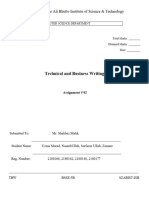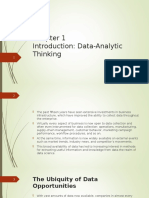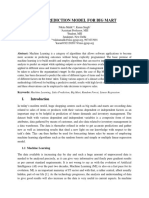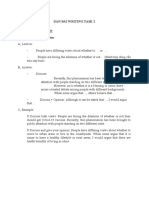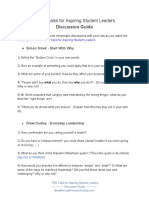Data Visualization Nanodegree Program Syllabus PDF
Uploaded by
sergio paredesData Visualization Nanodegree Program Syllabus PDF
Uploaded by
sergio paredesData Visualization Nanodegree
Program Syllabus
Craft impactful narratives with data visualization and storytelling
Before You Start
Prerequisites: This program is appropriate for students with some experience with data analysis. You
should understand descriptive statistics, such as calculating measures of center (mean, median, mode),
measures of spread (variance, standard deviation), and data distributions (normal distribution, skewness).
You should also be familiar with analyzing data in spreadsheets (Excel, Google Sheets, etc.). If you do not
have this background, there are courses included in the extracurricular section of the program to help you.
Educational Objectives: Students will learn to visualize data in order to support effective and impactful
presentations.
Estimated Length of Program: 4 months
Program Structure: Self-paced
Textbooks Required: None
COURSE 1: Intro to Data Visualization
In this course, you’ll learn the fundamentals of data visualization and design. You’ll learn to select the most
appropriate data visualization based on the goal of the analysis. You’ll learn important design elements for
graphically representing data. You’ll also learn to use Tableau to build interactive and engaging dashboards.
SUPPORTING LESSON CONTENT
Lesson Title Learning Outcomes
Data Visualization ➔ Evaluate the quality of data visualizations and build high-quality
Fundamentals visualizations.
Design Principles ➔ Implement the best design practices, and use the most
appropriate chart for a particular situation.
Creating Visualizations ➔ Build data visualizations in Tableau.
in Tableau ➔ Use data hierarchies, filters, groups, sets, and calculated fields.
➔ Create map-based data visualizations in Tableau.
Telling Stories with ➔ Build interactive Tableau dashboards.
Tableau ➔ Construct a data story using Tableau Storypoint
PROJECT 1: Build Data Dashboards
Sharing insights is an integral part of working with data. In this project, you’ll build interactive dashboards
with Tableau. You’ll use a dataset of flight delays in the US to visualize the quality of airlines and airports,
find the best times to fly, and more. These types of visualizations help guide decision making to reach the
best outcomes.
COURSE 2: Dashboard Design
In this course, you’ll learn the process of designing and creating dashboards within an enterprise
environment. You’ll learn to discover user needs, identify key metrics, and tailor your dashboard to a
particular audience. You’ll learn to use design elements to maximize the effectiveness of the dashboard and
how to iterate based on user feedback.
SUPPORTING LESSON CONTENT
Lesson Title Learning Outcomes
Planning Phase ➔ Uncover and understand user needs for a dashboard project.
➔ Determine the level of the audience's graphicacy.
➔ Identify measurable key metrics.
Design Phase ➔ Design a dashboard using sketching and wireframing.
➔ Build a simple dashboard prototype.
Prototyping & Feedback ➔ Gather feedback from dashboard users.
➔ Iterate on the prototype and complete a finished dashboard.
PROJECT 2: Design a Dashboard
In this project, you’ll design a dashboard for a specific audience which you’ll define by their graphicacy, data
literacy, domain expertise, user type, metrics that matter most, and any other attributes that might
influence the design. This dashboard’s main purpose is to ensure the appropriate data has been chosen for
decisions needing to be made. Then you’ll make the dashboard truly insightful by adding design elements
that draw the user’s eye to points of interest based on data. You’ll transform your visualizations to
emphasize the most important points and add interactivity further facilitating the users’ desired actions.
COURSE 3: Data Storytelling
In this course, you will learn the end to end process for telling a story and providing a recommendation
based on data. You’ll learn to create a “ghost deck” to define a problem statement, scope possible analyses,
and outline a set of potential solutions. You’ll also learn to identify what type of data analysis tool is
appropriate for specific types of visualizations. You will learn how to identify limitations and biases in data.
Lastly, you’ll learn to create a polished deck that uncovers the story from within the data through data
visualizations.
SUPPORTING LESSON CONTENT
Lesson Title Learning Outcomes
Define Problem ➔ Clearly articulate and communicate a problem statement for a
Statement data project.
Building a Ghost Deck ➔ Create an issue tree and hypothesis driven structure
➔ Create a “ghost deck” — a skeleton deck commonly used by
management consultants to identify a client’s needs.
Limitations and Biases ➔ Identify potential limitations and sources of bias in your
analyses.
➔ Communicate the appropriate caveats of a recommendation.
Delivering a Data ➔ Create an analyses roadmap that encompasses the analyses you
Presentation plan to do.
➔ Clearly articulate the “so what” of your analysis.
➔ Communicate your data story to support a concise set of
recommendations.
PROJECT 3: Build a Data Story
In this project, you’ll take the role of a data science consultant for a large production company and use the
Movies Metadata dataset to provide insights on key takeaways for a specific problem statement. You’ll
create a ghost deck to with a problem statement, potential analyses, and a set of potential
recommendations. Then you will identify the limitations and biases in data that affect the
recommendations. You’ll perform various analysis to understand and find insights from the dataset. Lastly,
you’ll put it all together by combining your ghost deck and your analyses to provide a final recommendation.
COURSE 4: Advanced Data Storytelling
In this course, you’ll learn advanced data visualization and storytelling techniques. You will learn about the
various types of data stories and how to find and use them effectively. You’ll learn to use Tableau Storypoint
to add interactivity and other visual elements to a story. Then you’ll learn to add animation and narration to
your analyses with both Tableau Pages and Flourish.
SUPPORTING LESSON CONTENT
Lesson Title Learning Outcomes
Eight Data Story Types ➔ Identify the different data story types and how to find and use
them to tell interesting data stories.
Creating Stories in ➔ Add interactivity to data stories.
Tableau ➔ Create an interactive data story in Tableau Storypoint.
Animating Data ➔ Understand the use cases for animating data.
➔ Create an animated dashboard with Tableau Pages.
Animation and Narration ➔ Add audio and narration to your data stories using Flourish.
➔ Create Flourish interactive stories.
PROJECT 4: Animate a Data Story
In this project, you will use a World Bank Indicators data file to create an interactive data presentation using
indicators of your choice. You will choose the fields for various dimensions (e.g., country, year) and identify
trends and patterns in the data set. In the final part of the project, you will create an animated data story
and add an audio track to create a narrated finished product that you can add to your portfolio.
You might also like
- Download Full Growth Modeling Structural Equation and Multilevel Modeling Approaches 1st Edition Kevin J. Grimm PDF All Chapters100% (5)Download Full Growth Modeling Structural Equation and Multilevel Modeling Approaches 1st Edition Kevin J. Grimm PDF All Chapters81 pages
- Ralph Kimball, Laura Reeves, Margy Ross, Warren Thornthwaite - The Data Warehouse Lifecycle Toolkit - Expert Methods For Designing, Developing, and Deploying Data Warehouses-Wiley (1998)No ratings yetRalph Kimball, Laura Reeves, Margy Ross, Warren Thornthwaite - The Data Warehouse Lifecycle Toolkit - Expert Methods For Designing, Developing, and Deploying Data Warehouses-Wiley (1998)9 pages
- The Power of Data Storytelling by Sejal Vora 2019 9789353282905 9789353282912 CompressNo ratings yetThe Power of Data Storytelling by Sejal Vora 2019 9789353282905 9789353282912 Compress249 pages
- Uop Sorbex Family of Technologies: James A. JohnsonNo ratings yetUop Sorbex Family of Technologies: James A. Johnson8 pages
- Statements That Imply Your Higher Value - Chateau Heartiste PDFNo ratings yetStatements That Imply Your Higher Value - Chateau Heartiste PDF68 pages
- An Ecocritical Reading of Hayao Miyazaki's Nausicaa of The Valley of The Wind: Territory, Toxicity, and AnimalsNo ratings yetAn Ecocritical Reading of Hayao Miyazaki's Nausicaa of The Valley of The Wind: Territory, Toxicity, and Animals27 pages
- Getting Data Science Done: Managing Projects From Ideas to ProductsFrom EverandGetting Data Science Done: Managing Projects From Ideas to ProductsNo ratings yet
- How To Win With Your Data Visualizations The 5 Part Guide For Junior Analysts To Create Effective Data Visualizations And... (Clarke, Elizabeth) (Z-Library)No ratings yetHow To Win With Your Data Visualizations The 5 Part Guide For Junior Analysts To Create Effective Data Visualizations And... (Clarke, Elizabeth) (Z-Library)249 pages
- Data Science in E-Commerce - Report - WritingNo ratings yetData Science in E-Commerce - Report - Writing18 pages
- (AK Peters Visualization Series) Neil Richards - Questions in Dataviz_ a Design-Driven Process for Data Visualisation-CRC Press_ an a K Peters (2022)No ratings yet(AK Peters Visualization Series) Neil Richards - Questions in Dataviz_ a Design-Driven Process for Data Visualisation-CRC Press_ an a K Peters (2022)367 pages
- Everything You Need For Clear and Efficient Data VisualizationNo ratings yetEverything You Need For Clear and Efficient Data Visualization41 pages
- Complete Download An Introduction to Statistical Learning: with Applications in Python Gareth James PDF All ChaptersNo ratings yetComplete Download An Introduction to Statistical Learning: with Applications in Python Gareth James PDF All Chapters55 pages
- Customer Satisfaction and Brand Loyalty Dissertation100% (1)Customer Satisfaction and Brand Loyalty Dissertation5 pages
- The Data Science Framework: Juan J. Cuadrado-Gallego Yuri DemchenkoNo ratings yetThe Data Science Framework: Juan J. Cuadrado-Gallego Yuri Demchenko202 pages
- Guide To Create: Beautiful Graphics in RNo ratings yetGuide To Create: Beautiful Graphics in R48 pages
- Programming For Data Science With Python Nanodegree Program SyllabusNo ratings yetProgramming For Data Science With Python Nanodegree Program Syllabus10 pages
- Natural Language Processing State of The Art CurreNo ratings yetNatural Language Processing State of The Art Curre26 pages
- Publication Bias in Meta-Analysis: Prevention, Assessment and AdjustmentsFrom EverandPublication Bias in Meta-Analysis: Prevention, Assessment and AdjustmentsNo ratings yet
- Chapter 1 - Chapter 1 Introduction: Data-Analytic ThinkingNo ratings yetChapter 1 - Chapter 1 Introduction: Data-Analytic Thinking54 pages
- Item-Based Collaborative Filtering Recommendation AlgorithmsNo ratings yetItem-Based Collaborative Filtering Recommendation Algorithms11 pages
- Andrew Treadway - Software Engineering For Data Scientists (MEAP V03) - Manning Publications (2023)No ratings yetAndrew Treadway - Software Engineering For Data Scientists (MEAP V03) - Manning Publications (2023)319 pages
- A Roadmap For Scaling Self-Service Analytics 1.0100% (1)A Roadmap For Scaling Self-Service Analytics 1.013 pages
- Beyond The Cookie Mapping The Future of Marketing Measurement Final100% (1)Beyond The Cookie Mapping The Future of Marketing Measurement Final25 pages
- Abell Model-Business Modeling - (Chapter 2 MSO)No ratings yetAbell Model-Business Modeling - (Chapter 2 MSO)35 pages
- FinalPaper SalesPredictionModelforBigMartNo ratings yetFinalPaper SalesPredictionModelforBigMart14 pages
- Weka A Tool For Exploratory Data MiningNo ratings yetWeka A Tool For Exploratory Data Mining157 pages
- Big Data and Social Media Analytics Trending Applications by Mehmet Çakırtaş, Mehmet Kemal OzdemirNo ratings yetBig Data and Social Media Analytics Trending Applications by Mehmet Çakırtaş, Mehmet Kemal Ozdemir246 pages
- Data Science Skills They Dont Teach YouNo ratings yetData Science Skills They Dont Teach You72 pages
- (Skiena, 2017) - Book - The Data Science Design Manual - 3No ratings yet(Skiena, 2017) - Book - The Data Science Design Manual - 31 page
- How To Calculate Precision, Recall, and F-Measure For Imbalanced ClassificationNo ratings yetHow To Calculate Precision, Recall, and F-Measure For Imbalanced Classification19 pages
- Recommender System For Improving Customer Loyalty PDF100% (1)Recommender System For Improving Customer Loyalty PDF133 pages
- Big Data and Analytics: The key concepts and practical applications of big data analytics (English Edition)From EverandBig Data and Analytics: The key concepts and practical applications of big data analytics (English Edition)No ratings yet
- Making Big Data Work for Your Business: A guide to effective Big Data analyticsFrom EverandMaking Big Data Work for Your Business: A guide to effective Big Data analyticsNo ratings yet
- Functional Skills Criteria For English: Entry 1, Entry 2, Entry 3, Level 1 and Level 2No ratings yetFunctional Skills Criteria For English: Entry 1, Entry 2, Entry 3, Level 1 and Level 213 pages
- Fitts & Posner Stages of Motor Skill Learning PDFNo ratings yetFitts & Posner Stages of Motor Skill Learning PDF1 page
- Success Story: How Alan Cristea Gallery Reimagined Their Digital Sales StrategyNo ratings yetSuccess Story: How Alan Cristea Gallery Reimagined Their Digital Sales Strategy8 pages
- An Integrated Brain-Machine Interface Platform With Thousands of ChannelsNo ratings yetAn Integrated Brain-Machine Interface Platform With Thousands of Channels12 pages
- Master in Theoretical and Practical Application of FEM and CAE SimulationNo ratings yetMaster in Theoretical and Practical Application of FEM and CAE Simulation20 pages
- UMak Online Issuance of Report of Grades v1.2.2No ratings yetUMak Online Issuance of Report of Grades v1.2.21 page
- Nanzan University Asian Folklore StudiesNo ratings yetNanzan University Asian Folklore Studies11 pages
- Notice: Committees Establishment, Renewal, Termination, Etc.: Farm, Ranch, and Rural Communities Advisory CommitteeNo ratings yetNotice: Committees Establishment, Renewal, Termination, Etc.: Farm, Ranch, and Rural Communities Advisory Committee1 page
- Discussion Guide TED Talks For Aspiring Student LeadersNo ratings yetDiscussion Guide TED Talks For Aspiring Student Leaders4 pages
- Ridge Lines Newsletter, Summer-Fall 2008 Bay Area Ridge Trail CouncilNo ratings yetRidge Lines Newsletter, Summer-Fall 2008 Bay Area Ridge Trail Council8 pages
- Leap Scholar - IELTS Speaking TOPICS - 2021 (V2) Part 1 and Part 2No ratings yetLeap Scholar - IELTS Speaking TOPICS - 2021 (V2) Part 1 and Part 223 pages
- Guidelines For Strategic Management Paper Oral Defense For The Panel MembersNo ratings yetGuidelines For Strategic Management Paper Oral Defense For The Panel Members4 pages
- Download Full Growth Modeling Structural Equation and Multilevel Modeling Approaches 1st Edition Kevin J. Grimm PDF All ChaptersDownload Full Growth Modeling Structural Equation and Multilevel Modeling Approaches 1st Edition Kevin J. Grimm PDF All Chapters
- Ralph Kimball, Laura Reeves, Margy Ross, Warren Thornthwaite - The Data Warehouse Lifecycle Toolkit - Expert Methods For Designing, Developing, and Deploying Data Warehouses-Wiley (1998)Ralph Kimball, Laura Reeves, Margy Ross, Warren Thornthwaite - The Data Warehouse Lifecycle Toolkit - Expert Methods For Designing, Developing, and Deploying Data Warehouses-Wiley (1998)
- The Power of Data Storytelling by Sejal Vora 2019 9789353282905 9789353282912 CompressThe Power of Data Storytelling by Sejal Vora 2019 9789353282905 9789353282912 Compress
- Uop Sorbex Family of Technologies: James A. JohnsonUop Sorbex Family of Technologies: James A. Johnson
- Statements That Imply Your Higher Value - Chateau Heartiste PDFStatements That Imply Your Higher Value - Chateau Heartiste PDF
- An Ecocritical Reading of Hayao Miyazaki's Nausicaa of The Valley of The Wind: Territory, Toxicity, and AnimalsAn Ecocritical Reading of Hayao Miyazaki's Nausicaa of The Valley of The Wind: Territory, Toxicity, and Animals
- Getting Data Science Done: Managing Projects From Ideas to ProductsFrom EverandGetting Data Science Done: Managing Projects From Ideas to Products
- How To Win With Your Data Visualizations The 5 Part Guide For Junior Analysts To Create Effective Data Visualizations And... (Clarke, Elizabeth) (Z-Library)How To Win With Your Data Visualizations The 5 Part Guide For Junior Analysts To Create Effective Data Visualizations And... (Clarke, Elizabeth) (Z-Library)
- (AK Peters Visualization Series) Neil Richards - Questions in Dataviz_ a Design-Driven Process for Data Visualisation-CRC Press_ an a K Peters (2022)(AK Peters Visualization Series) Neil Richards - Questions in Dataviz_ a Design-Driven Process for Data Visualisation-CRC Press_ an a K Peters (2022)
- Everything You Need For Clear and Efficient Data VisualizationEverything You Need For Clear and Efficient Data Visualization
- Complete Download An Introduction to Statistical Learning: with Applications in Python Gareth James PDF All ChaptersComplete Download An Introduction to Statistical Learning: with Applications in Python Gareth James PDF All Chapters
- Customer Satisfaction and Brand Loyalty DissertationCustomer Satisfaction and Brand Loyalty Dissertation
- The Data Science Framework: Juan J. Cuadrado-Gallego Yuri DemchenkoThe Data Science Framework: Juan J. Cuadrado-Gallego Yuri Demchenko
- Programming For Data Science With Python Nanodegree Program SyllabusProgramming For Data Science With Python Nanodegree Program Syllabus
- Natural Language Processing State of The Art CurreNatural Language Processing State of The Art Curre
- Publication Bias in Meta-Analysis: Prevention, Assessment and AdjustmentsFrom EverandPublication Bias in Meta-Analysis: Prevention, Assessment and Adjustments
- Chapter 1 - Chapter 1 Introduction: Data-Analytic ThinkingChapter 1 - Chapter 1 Introduction: Data-Analytic Thinking
- Item-Based Collaborative Filtering Recommendation AlgorithmsItem-Based Collaborative Filtering Recommendation Algorithms
- Andrew Treadway - Software Engineering For Data Scientists (MEAP V03) - Manning Publications (2023)Andrew Treadway - Software Engineering For Data Scientists (MEAP V03) - Manning Publications (2023)
- Beyond The Cookie Mapping The Future of Marketing Measurement FinalBeyond The Cookie Mapping The Future of Marketing Measurement Final
- Big Data and Social Media Analytics Trending Applications by Mehmet Çakırtaş, Mehmet Kemal OzdemirBig Data and Social Media Analytics Trending Applications by Mehmet Çakırtaş, Mehmet Kemal Ozdemir
- (Skiena, 2017) - Book - The Data Science Design Manual - 3(Skiena, 2017) - Book - The Data Science Design Manual - 3
- How To Calculate Precision, Recall, and F-Measure For Imbalanced ClassificationHow To Calculate Precision, Recall, and F-Measure For Imbalanced Classification
- Recommender System For Improving Customer Loyalty PDFRecommender System For Improving Customer Loyalty PDF
- Big Data and Analytics: The key concepts and practical applications of big data analytics (English Edition)From EverandBig Data and Analytics: The key concepts and practical applications of big data analytics (English Edition)
- Making Big Data Work for Your Business: A guide to effective Big Data analyticsFrom EverandMaking Big Data Work for Your Business: A guide to effective Big Data analytics
- Functional Skills Criteria For English: Entry 1, Entry 2, Entry 3, Level 1 and Level 2Functional Skills Criteria For English: Entry 1, Entry 2, Entry 3, Level 1 and Level 2
- Success Story: How Alan Cristea Gallery Reimagined Their Digital Sales StrategySuccess Story: How Alan Cristea Gallery Reimagined Their Digital Sales Strategy
- An Integrated Brain-Machine Interface Platform With Thousands of ChannelsAn Integrated Brain-Machine Interface Platform With Thousands of Channels
- Master in Theoretical and Practical Application of FEM and CAE SimulationMaster in Theoretical and Practical Application of FEM and CAE Simulation
- Notice: Committees Establishment, Renewal, Termination, Etc.: Farm, Ranch, and Rural Communities Advisory CommitteeNotice: Committees Establishment, Renewal, Termination, Etc.: Farm, Ranch, and Rural Communities Advisory Committee
- Discussion Guide TED Talks For Aspiring Student LeadersDiscussion Guide TED Talks For Aspiring Student Leaders
- Ridge Lines Newsletter, Summer-Fall 2008 Bay Area Ridge Trail CouncilRidge Lines Newsletter, Summer-Fall 2008 Bay Area Ridge Trail Council
- Leap Scholar - IELTS Speaking TOPICS - 2021 (V2) Part 1 and Part 2Leap Scholar - IELTS Speaking TOPICS - 2021 (V2) Part 1 and Part 2
- Guidelines For Strategic Management Paper Oral Defense For The Panel MembersGuidelines For Strategic Management Paper Oral Defense For The Panel Members













